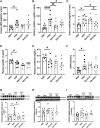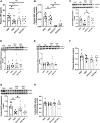Combining Neprilysin Inhibitor With AT2R Agonist Is Superior to Combination With AT1R Blocker in Providing Reno-Protection in Obese Rats
- PMID: 35197849
- PMCID: PMC8859315
- DOI: 10.3389/fphar.2021.778953
Combining Neprilysin Inhibitor With AT2R Agonist Is Superior to Combination With AT1R Blocker in Providing Reno-Protection in Obese Rats
Abstract
Clinical use of the combination therapy of the neprilysin inhibitor sacubitril and angiotensin II type 1 receptor blocker valsartan is known to be associated with albuminuria. Albuminuria is both a risk factor for and an indicator of kidney injury. Earlier work from our laboratory reported that the agonist of angiotensin II type 2 receptor Compound 21 (C21) prevents proteinuria, albuminuria, and is reno-protective in obese Zucker rats fed high salt diet (HSD). Thus, we hypothesized that sacubitril/C21 combination provides superior reno-protection compared to sacubitril/valsartan. Male obese Zucker rats 10-11 weeks old were treated daily with vehicle, sacubitril + C21, or sacubitril + valsartan while fed HSD for 16 days. HSD-feeding caused kidney dysfunction, evident by significant increases in urinary protein, osteopontin, and cystatin C. HSD-feeding lowered plasma cystatin C and creatinine concentrations suggestive of hyperfiltration, which was not affected by either treatment. Unlike sacubitril/valsartan, sacubitril/C21 treatment significantly decreases proteinuria, albuminuria, the expression of nephrin, and kidney weight, independent of hyperfiltration, compared with HSD alone. Moreover, sacubitril/valsartan therapy increased plasma renin and did not prevent HSD-induced increases in renal angiotensin II, while sacubitril/C21 completely prevented these changes. Together, this study suggests that sacubitril/C21 afforded superior reno-protection compared to sacubitril/valsartan therapy in high salt-fed obese Zucker rats.
Keywords: angiotensin II type 2 receptor agonist; angiotensin receptor blocker; neprilysin inhibition; obesity; proteinuria; reno-protection.
Copyright © 2022 Gray, Patel, Doris and Hussain.
Conflict of interest statement
The authors declare that the research was conducted in the absence of any commercial or financial relationships that could be construed as a potential conflict of interest.
Figures




Similar articles
-
Angiotensin AT2 receptor agonist prevents salt-sensitive hypertension in obese Zucker rats.Am J Physiol Renal Physiol. 2015 Jun 15;308(12):F1379-85. doi: 10.1152/ajprenal.00002.2015. Epub 2015 Apr 8. Am J Physiol Renal Physiol. 2015. PMID: 25855512 Free PMC article.
-
The combination of a neprilysin inhibitor (sacubitril) and angiotensin-II receptor blocker (valsartan) attenuates glomerular and tubular injury in the Zucker Obese rat.Cardiovasc Diabetol. 2019 Mar 25;18(1):40. doi: 10.1186/s12933-019-0847-8. Cardiovasc Diabetol. 2019. PMID: 30909895 Free PMC article.
-
Angiotensin II Type 2-Receptor Agonist C21 Reduces Proteinuria and Oxidative Stress in Kidney of High-Salt-Fed Obese Zucker Rats.Hypertension. 2016 May;67(5):906-15. doi: 10.1161/HYPERTENSIONAHA.115.06881. Epub 2016 Mar 28. Hypertension. 2016. PMID: 27021008 Free PMC article.
-
Dual Angiotensin Receptor and Neprilysin Inhibition with Sacubitril/Valsartan in Chronic Systolic Heart Failure: Understanding the New PARADIGM.Ann Pharmacother. 2015 Nov;49(11):1237-51. doi: 10.1177/1060028015593093. Epub 2015 Jul 14. Ann Pharmacother. 2015. PMID: 26175499 Review.
-
Sacubitril/valsartan: An important piece in the therapeutic puzzle of heart failure.Rev Port Cardiol. 2017 Sep;36(9):655-668. doi: 10.1016/j.repc.2016.11.013. Epub 2017 Aug 23. Rev Port Cardiol. 2017. PMID: 28844335 Review. English, Portuguese.
Cited by
-
Updates for Cardio-Kidney Protective Effects by Angiotensin Receptor-Neprilysin Inhibitor: Requirement for Additional Evidence of Kidney Protection.J Am Heart Assoc. 2023 Apr 18;12(8):e029565. doi: 10.1161/JAHA.122.029565. Epub 2023 Apr 17. J Am Heart Assoc. 2023. PMID: 37066800 Free PMC article. Review.
References
-
- Azizi M., Ménard J., Bissery A., Guyenne T. T., Bura-Rivière A., Vaidyanathan S., et al. (2004). Pharmacologic Demonstration of the Synergistic Effects of a Combination of the Renin Inhibitor Aliskiren and the AT1 Receptor Antagonist Valsartan on the Angiotensin II-Renin Feedback Interruption. J. Am. Soc. Nephrol. 15, 3126–3133. 10.1097/01.ASN.0000146686.35541.29 - DOI - PubMed
LinkOut - more resources
Full Text Sources
Research Materials

